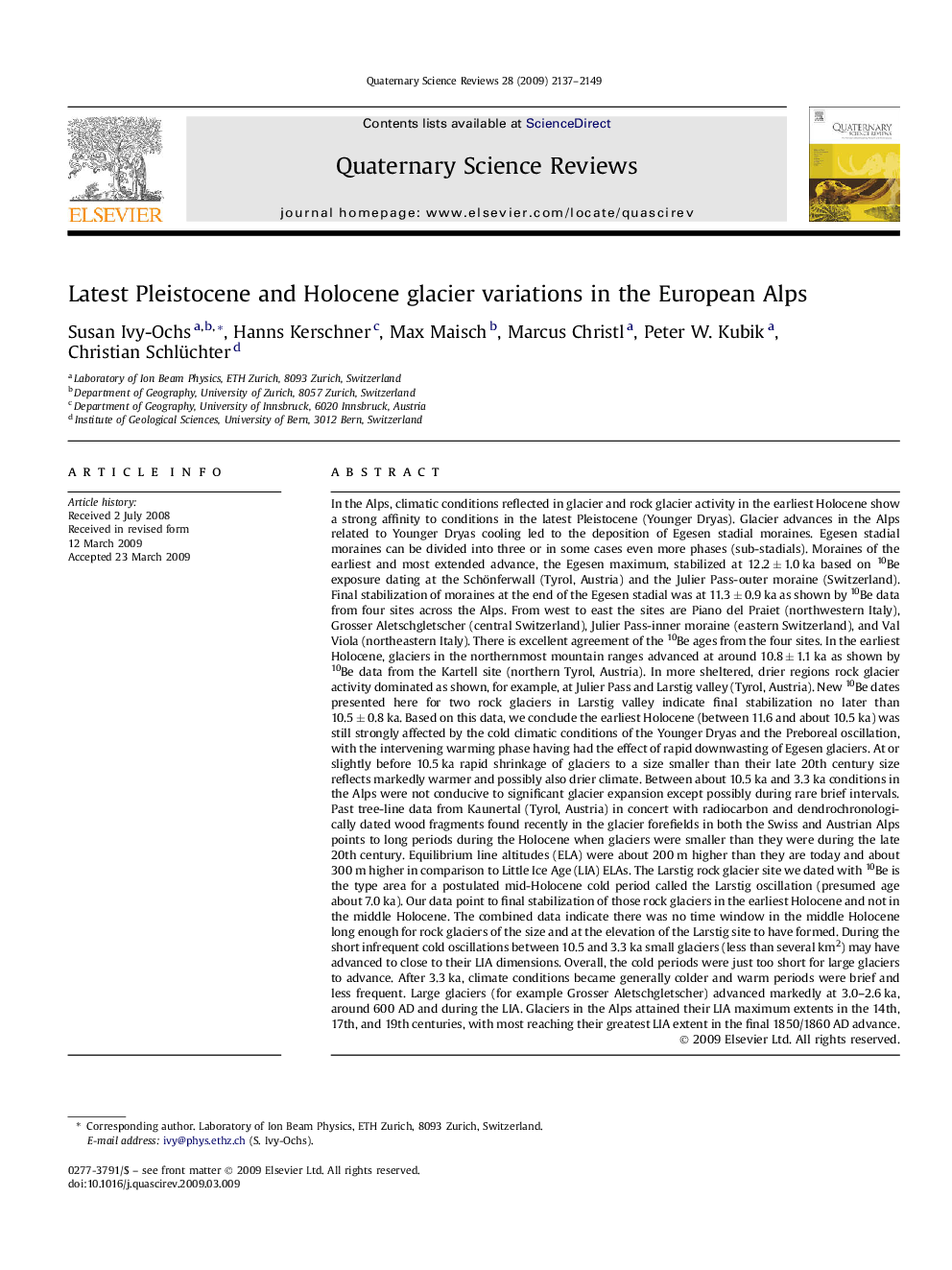| Article ID | Journal | Published Year | Pages | File Type |
|---|---|---|---|---|
| 4737951 | Quaternary Science Reviews | 2009 | 13 Pages |
In the Alps, climatic conditions reflected in glacier and rock glacier activity in the earliest Holocene show a strong affinity to conditions in the latest Pleistocene (Younger Dryas). Glacier advances in the Alps related to Younger Dryas cooling led to the deposition of Egesen stadial moraines. Egesen stadial moraines can be divided into three or in some cases even more phases (sub-stadials). Moraines of the earliest and most extended advance, the Egesen maximum, stabilized at 12.2 ± 1.0 ka based on 10Be exposure dating at the Schönferwall (Tyrol, Austria) and the Julier Pass-outer moraine (Switzerland). Final stabilization of moraines at the end of the Egesen stadial was at 11.3 ± 0.9 ka as shown by 10Be data from four sites across the Alps. From west to east the sites are Piano del Praiet (northwestern Italy), Grosser Aletschgletscher (central Switzerland), Julier Pass-inner moraine (eastern Switzerland), and Val Viola (northeastern Italy). There is excellent agreement of the 10Be ages from the four sites. In the earliest Holocene, glaciers in the northernmost mountain ranges advanced at around 10.8 ± 1.1 ka as shown by 10Be data from the Kartell site (northern Tyrol, Austria). In more sheltered, drier regions rock glacier activity dominated as shown, for example, at Julier Pass and Larstig valley (Tyrol, Austria). New 10Be dates presented here for two rock glaciers in Larstig valley indicate final stabilization no later than 10.5 ± 0.8 ka. Based on this data, we conclude the earliest Holocene (between 11.6 and about 10.5 ka) was still strongly affected by the cold climatic conditions of the Younger Dryas and the Preboreal oscillation, with the intervening warming phase having had the effect of rapid downwasting of Egesen glaciers. At or slightly before 10.5 ka rapid shrinkage of glaciers to a size smaller than their late 20th century size reflects markedly warmer and possibly also drier climate. Between about 10.5 ka and 3.3 ka conditions in the Alps were not conducive to significant glacier expansion except possibly during rare brief intervals. Past tree-line data from Kaunertal (Tyrol, Austria) in concert with radiocarbon and dendrochronologically dated wood fragments found recently in the glacier forefields in both the Swiss and Austrian Alps points to long periods during the Holocene when glaciers were smaller than they were during the late 20th century. Equilibrium line altitudes (ELA) were about 200 m higher than they are today and about 300 m higher in comparison to Little Ice Age (LIA) ELAs. The Larstig rock glacier site we dated with 10Be is the type area for a postulated mid-Holocene cold period called the Larstig oscillation (presumed age about 7.0 ka). Our data point to final stabilization of those rock glaciers in the earliest Holocene and not in the middle Holocene. The combined data indicate there was no time window in the middle Holocene long enough for rock glaciers of the size and at the elevation of the Larstig site to have formed. During the short infrequent cold oscillations between 10.5 and 3.3 ka small glaciers (less than several km2) may have advanced to close to their LIA dimensions. Overall, the cold periods were just too short for large glaciers to advance. After 3.3 ka, climate conditions became generally colder and warm periods were brief and less frequent. Large glaciers (for example Grosser Aletschgletscher) advanced markedly at 3.0–2.6 ka, around 600 AD and during the LIA. Glaciers in the Alps attained their LIA maximum extents in the 14th, 17th, and 19th centuries, with most reaching their greatest LIA extent in the final 1850/1860 AD advance.
